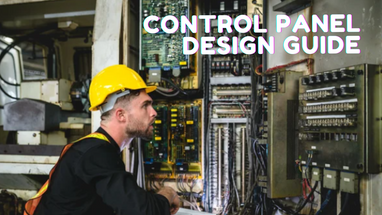Jun 12th 2025
Control Panel Design Guide: Best Practices for Industrial Automation
Industrial Control Panels (ICPs) are foundational to modern automation systems, managing power distribution, signal control, and machine interfacing. Whether modular or custom-built, a properly designed panel ensures system reliability, safety, and maintainability. This guide combines best practices, industry standards, and real-world component solutions—including offerings from Automation Distribution—to walk you through effective panel design from start to finish.
What is an Industrial Control Panel?
An Industrial Control Panel (ICP) is an enclosed or open assembly of electrical components—PLCs, drives, relays, and power distribution devices—that monitors and controls industrial equipment. It operates below 600V, typically incorporating transformers to step down power and excludes the machinery it controls.
Key Standards and Compliance Requirements
Designs must comply with:
- NFPA 70 (NEC) – Electrical safety and installation
- NFPA 79 – Industrial machinery
- UL 508A – U.S. standard for ICPs
- IEC 60204-1 – International electrical machinery safety
- CSA C22.2 – Canada’s electrical code
Automation Distribution supports compliance through UL-listed components and enclosure solutions suitable for various certification environments.
Modular vs. Custom Panel Applications
- Modular Panels are repeatable and mass-produced (e.g., for robot controllers).
- Custom Panels are tailored for specific machine designs or process systems.
Panel Design Process (With Product Examples)
Step 1: Controlled System Design
Define the machinery and automation architecture. Determine:
- Input/output device types and counts
- Required voltages and safety devices
- Communication protocols (Ethernet/IP, Profinet, IO-Link)
Step 2: Functional Specification
Develop operational block diagrams, safety logic, and interlocks. Consider environmental factors that may affect product selection (e.g., IP ratings for wet areas).
Step 3: Electrical Schematics & I/O Diagram
Use tools like AutoCAD Electrical, EPLAN, or Zuken E3 for:
- Power distribution maps
- PLC wiring
- Terminal layouts
Automation Distribution Examples:
- PLCs: SMC EX600-W Series for modular IO-Link networks
- Terminal Blocks: WAGO 2002 Series for compact DIN rail mounting
- Surge Protection: Schneider Electric Surgelogic for signal line protection
- Relays: SMC Magnetic Field Resistant Solid State Auto Switch for solid-state switching
Step 4: Enclosure and Layout Design
Use 2D/3D CAD tools to organize:
- Disconnects, power supply at the top
- PLC and relays in the center
- Terminal blocks at the bottom
Automation Distribution Examples:
- Enclosures: ABB TE100CS Enclosure for washdown applications
- Cooling: Pfannenberg DTS Series filter fan kits or air conditioners
- DIN Rail Accessories: WAGO end stops
Step 5: Component Selection
Choose components based on:
- Electrical ratings
- Diagnostic capabilities
- Environmental and application fit
Automation Distribution Categories:
- Circuit Breakers: ABB Circuit Breakers
- Motor Starters: ABB Contactors and Overloads
- VFDs: Inverkek Drives
- Power Supplies: PULS DIN-Rail Units
- Safety Relays: ABB Jokab Safety
Thermal Management
Ensure heat dissipation with:
- Passive cooling or louvered ventilation for low-density panels
- Closed-loop cooling or air conditioners in washdown or high-dust areas
Automation Distribution Options:
- Pfannenberg Thermal Management Systems – panel coolers, heaters, and fans
Wiring and Assembly Best Practices
- Color-code and label wires per NEC or IEC
- Use ferrules and torque-verified terminals
- Bundle and secure wires in ducts
Automation Distribution Tools:
- Wire Management: ABB Wire Management
- Ferrules and Crimp Tools: ABB Ferrules
Safety Considerations
Design for compliance and operator protection:
- Lockable disconnects
- E-stops and pilot devices
- Safety relays and interlocks
Automation Distribution Safety Devices:
- Emergency Stop Units: ABB Stop Switches
- Safety Controllers: Lenze Safety Controllers
- Light Curtains: Leuze Safety Light Curtains
Testing and Validation
Conduct:
- Point-to-point verification
- Continuity and insulation testing
- Function and safety circuit testing
Log test results during Factory Acceptance Testing (FAT) for traceability.
Documentation and BOM
Include:
- Electrical schematics
- I/O maps
- Layout drawings
- BOM (Bill of Materials)
- User manuals and safety documentation
Automation Distribution can assist with quoting complete BOMs via custom kits or configured panel packages.
Future-Proofing
Design for adaptability:
- Allow extra DIN rail space
- Use expandable PLCs and fieldbus I/O
- Incorporate smart diagnostics and remote access
Forward-Looking Solutions from Automation Distribution:
- Edge Controllers: Exor MicroEdge
- Smart I/O Systems: Turck TBEN-L5 series for block-style field I/O
- Remote Access: Leuze Profinet Gateway
A successful industrial control panel is more than just wires and enclosures—it’s a fully integrated system that reflects smart engineering, safety compliance, and foresight. With the right approach—and access to reliable components from suppliers like Automation Distribution—you can build scalable, durable, and code-compliant panels that serve your automation goals for years to come.
Contact our engineering department today to guide you in the most cost-effective, strategic solution for your application at 1-888-600-3080.

